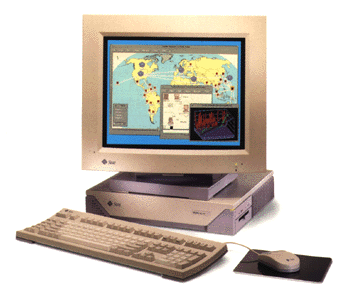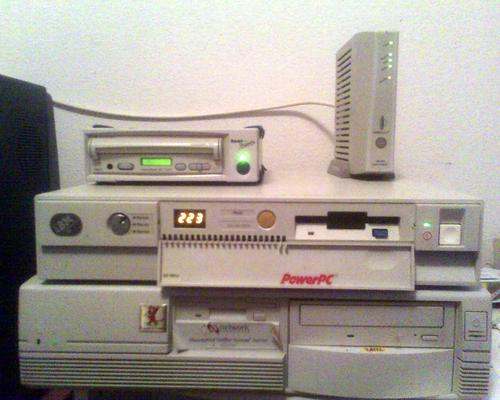
Manufacturer: Sun Microsystems
Model: SparcStation 5
CPU: MicroSparc II, 80 MHz
RAM: 64 MB (Upgraded from 32 MB)
HDD: SCSI 73GB (Upgraded from 2GB)
Release Date: Mid-1994 (Most likely August)
(Stock photo shown)
There are a few of the hardware underdogs that I admire. Sun Microsystems has always been on my short list. Those of us who are sysadmins and have been for a while might not understand me calling Sun an "underdog". The general population has no idea they exist, though. Mention Dell, Apple or IBM and normal people know what you're talking about. Talking about Sun, Silicon Graphics, or Cray will certainly draw a few blank stares unless you're in the presence of geeks.
Historically, the SS5 wasn't truly groundbreaking. It was designed to be a compromise platform, nestled neatly between the rather inflexible entry-level SparcStation 4 and the more feature-packed and expensive SparcStation 20.
I actually acquired my SparcStation 5 from a table of "free" stuff at one of my old jobs about a year ago. It's easy to tell that this was already a dinosaur by the time I'd rescued it. It had Solaris 8 already installed, but it had an unknown root password. That doesn't stop me, but I had already decided that Solaris wasn't this machine's destiny. I have a somewhat newer (but still 90's era) Sun Ultra 5 for running Solaris. More on the U5 later on.
I originally installed OpenBSD 3.8 on the original 2GB SCSI hard drive. I used it as my primary "gateway" machine; My firewall would pass all SSH traffic to my SS5. Even after a fairly minimal installation of OpenBSD, there wasn't much in the way of drive space left. X.Org didn't work with the on-board video card, which required a 13W3 VGA adapter anyways. I left well enough alone and it was used as a headless terminal.
When OpenBSD 3.9 was released, I thought about upgrading it. I decided that along with upgrading the operating system, I would upgrade the RAM and HDD as well. I slapped a 73GB drive in (the SS5 requires SCA80-style drives) and doubled the RAM to 64MB. The newer X.Org that shipped with OpenBSD 3.9 functions well at 1024x768 at 256 colors, so I went ahead and installed it as well as some normal GUI utilities that I use. I also purchased a 13W3 adapter so that I could use the video.
The SS5 is still my front line of ingress to my network from the outside. In this age of multiple GHz of processing speed, 80 MHz seems to do just fine for quite a few mundane tasks. I won't be watching video podcasts or even editing graphics with GIMP on it. It currently runs as my primary testing environment for PHP, MySQL and NewLISP.
OpenBSD is just about as cutting-edge as you can get. This system is more than a decade old and yet remains just as functional as the day it was released, running applications and services that were just released weeks ago on a modern operating system. It's by no means the oldest functional computer I own. That said, if my incessant rambling about using old computers in a modern world had to be defined by one system in my posession, the SS5 would be it.

